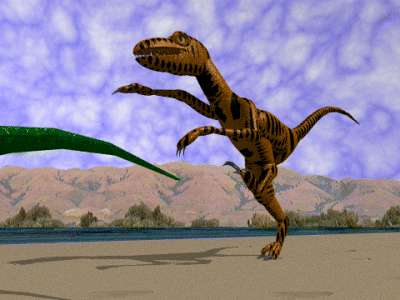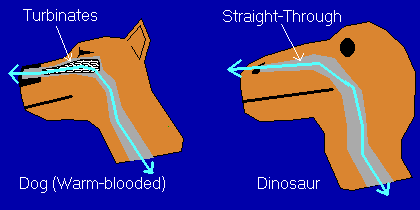Hot and Cold Running Dinosaurs


 An
Ultraraptor attack: Did it kill in cold blood? (Copyright
Lee Krystek 1996)
An
Ultraraptor attack: Did it kill in cold blood? (Copyright
Lee Krystek 1996)
The velociraptor sneaks up to the window and
looks through. His hot breath fogs the glass. Through the mist
he draws a bead on his next victims...
Was this scene from the movie Jurassic Park
accurate? Were dinosaurs warm-blooded? Did they have the kind
of hot breath that would have fogged up a window?
The question of whether dinosaurs were warm-blooded,
like mammals and birds, or cold-blooded, like reptiles and fish,
has been debated since dinosaur fossils were first discovered
in 1825.
Cold-blooded, or ectothermic, animal's bodies
stay about the same temperature as the environment around them.
This means cold-blooded animals tend to be sluggish in cool
weather. In the morning a lizard must sun itself on a rock to
warm up before it can take on any vigorous activity.
Warm-blooded, or endothermic, animals generate
their own heat and maintain a nearly constant temperature no
matter what conditions are like outside the body. This means
that an animal, like a dog, can be active in even freezing weather.
Richard Owen, who named the dinosaur suborder
in 1841, speculated early on dinosaurs were a version of reptiles
that were very active and perhaps warm-blooded. Despite this
scientists that followed Owen classified dinosaur behavior as
lizard-like: Generally sluggish animals that dragged their tails
around because they couldn't lift them. Some scientists even
speculated that large sauropods, like the Apatosaurus
were so weak they could only stand by half floating in lakes.
This picture began to change in 1964 when John
Ostrom, a paleontologist at Yale, found a long, thin, scythe-like
claw in the rock next to the skeleton of a Deinonychus.
"Startling. I couldn't believe what I saw, " recalls Ostrom.
Close examination showed that the claw, similar
to ones found on the animal's hands, had been attached to the
foot. Ostrom wondered of what use a knife-like claw on the toe
would be. His conclusion was that the animal must have attacked
by jumping and slashing with its feet and hands while it counter-balanced
with its stiff tail. Very unreptile-like behavior.
Ostrom, along with paleontologist Robert Bakker,
began to argue that dinosaurs were much more active than had
been thought. The animals they pictured walked, even ran, with
their feet squarely under their shoulders. Ostrom, Bakker and
others also maintained that dinosaurs were perhaps more closely
related to birds than reptiles. Since birds are warm-blooded,
why not dinosaurs too?
Examination of dinosaur fossils seemed to suggest
they were indeed warm-blooded. The remains of microscopic holes
in the bone seemed to indicate tiny blood vessels had been trapped
by the rapid growing bone tissue. Any animal growing that fast
must be warm-blooded, scientists reasoned.
Museums soon started to mount their dinosaur exhibits
to reflect this new, active, warm-blooded view of the dinosaurs.
Skeletons on display were changed to show the animals in leaping
and running positions. Now, new evidence has been found that
suggests dinosaurs may not have been warm-blooded after all.
Tomasz Owerkowicz, a researcher at Harvard,
has worked with living animals, both lizard and mammal, and
shown that tiny blood vessels trapped in bone doesn't mean that
an animal is warm-blooded, but that the animal is very active.
He trained half his lab animals on tread mills everyday for
months, while the other half sat around in their cages. Upon
examining their bones he couldn't tell the cold-blooded ones
apart from the warm-blooded ones. He could only tell the active
ones from the couch potatoes.
 This
alone doesn't show that dinosaurs were cold-blooded, just that
the tiny-vessels trapped in their fossilized bones are a sign
that they were very active, not necessarily warm-blooded. The
new evidence that dinosaurs were cold-blooded comes from John
Ruben, a physiologist with Oregon State University. He noticed
that all warm-blooded animals alive now, both birds and mammals
(including humans), have tiny, thin, curled structures behind
their noses called turbinates. Cold-blooded animals don't
have them. The purpose of these structures are to cool the warm
air as it leaves the body during exhalation.
This
alone doesn't show that dinosaurs were cold-blooded, just that
the tiny-vessels trapped in their fossilized bones are a sign
that they were very active, not necessarily warm-blooded. The
new evidence that dinosaurs were cold-blooded comes from John
Ruben, a physiologist with Oregon State University. He noticed
that all warm-blooded animals alive now, both birds and mammals
(including humans), have tiny, thin, curled structures behind
their noses called turbinates. Cold-blooded animals don't
have them. The purpose of these structures are to cool the warm
air as it leaves the body during exhalation.
Since cool air holds less moisture than warm air
this causes water to condense on the turbinates (just like droplets
condense on the outside of a glass of ice water standing in
the hot summer air). An inhalation of dry air causes the droplets
on the turbinates to be reabsorbed and go back into the body.
This saves the animal from losing precious water. This is especially
important for warm-blooded animals because they breathe much
more, and much warmer, air in and out than do cold-blooded animals.
Ruben has shown fossilized dinosaur skulls lack
the boney ridges that turbinates would have attached to if dinosaurs
would had had them. He can find them in fossilized mammals
of the same period. This suggests dinosaurs weren't warm-blooded,
or at least not warm-blooded like animals today. Ruben notes
that this does not mean dinosaurs were sluggish as thought earlier
in this century. The evidence still favors very active, but
ectothermic, dinosaurs.
Could this be the final word on dinosaur metabolism?
Probably not. We are constantly learning more about prehistoric
creatures as scientists develop new ways to probe the past.
These new discoveries also open new questions. How could dinosaurs
be so active and not warm-blooded? Did they have some special
way of warming themselves up to get ready to run and fight?
We don't know. All we can say for sure is that dinosaurs are
even stranger than we had thought.
In April of 2000 scientists who had examined the
fossil of a dinosaur found in 1993 announced a startling discovery.
A CT (computerized tomogrpahy) of the chest area of a Tescelosaurus
dinosaur revealed something that looked like a four chambered
heart with a single arched aorta. Normally soft tissue is not
preserved in fossils, but the tescelosaurus, found in
South Dakota and nicknamed "Willo," was in exceptionally
good condition. What is particularly significant about this
find is that most reptiles alive today have a three chambered
heart. Of those few that do have four chambered hearts, like
crocodiles, they also have a double set of arteries. Only warm
blooded creatures, like birds, are known to have four chambered
hearts with single aortas.
Does this mean that dinosaurs, or at least some
dinosaurs, were warm blooded? Not all scientists are sure that
the CT really shows a heart. Others believe that dinosaurs may
have developed a wide variety of hearts and some species may
have been warm-blooded while others remained cold-blooded or
somewhere in between. What is certain is that the controversy
is not over yet.
 Next
Stop on Dinosaur Safari
Next
Stop on Dinosaur Safari

Copyright Lee Krystek 1996.
All Rights Reserved.




 This
alone doesn't show that dinosaurs were cold-blooded, just that
the tiny-vessels trapped in their fossilized bones are a sign
that they were very active, not necessarily warm-blooded. The
new evidence that dinosaurs were cold-blooded comes from John
Ruben, a physiologist with Oregon State University. He noticed
that all warm-blooded animals alive now, both birds and mammals
(including humans), have tiny, thin, curled structures behind
their noses called turbinates. Cold-blooded animals don't
have them. The purpose of these structures are to cool the warm
air as it leaves the body during exhalation.
This
alone doesn't show that dinosaurs were cold-blooded, just that
the tiny-vessels trapped in their fossilized bones are a sign
that they were very active, not necessarily warm-blooded. The
new evidence that dinosaurs were cold-blooded comes from John
Ruben, a physiologist with Oregon State University. He noticed
that all warm-blooded animals alive now, both birds and mammals
(including humans), have tiny, thin, curled structures behind
their noses called turbinates. Cold-blooded animals don't
have them. The purpose of these structures are to cool the warm
air as it leaves the body during exhalation.
